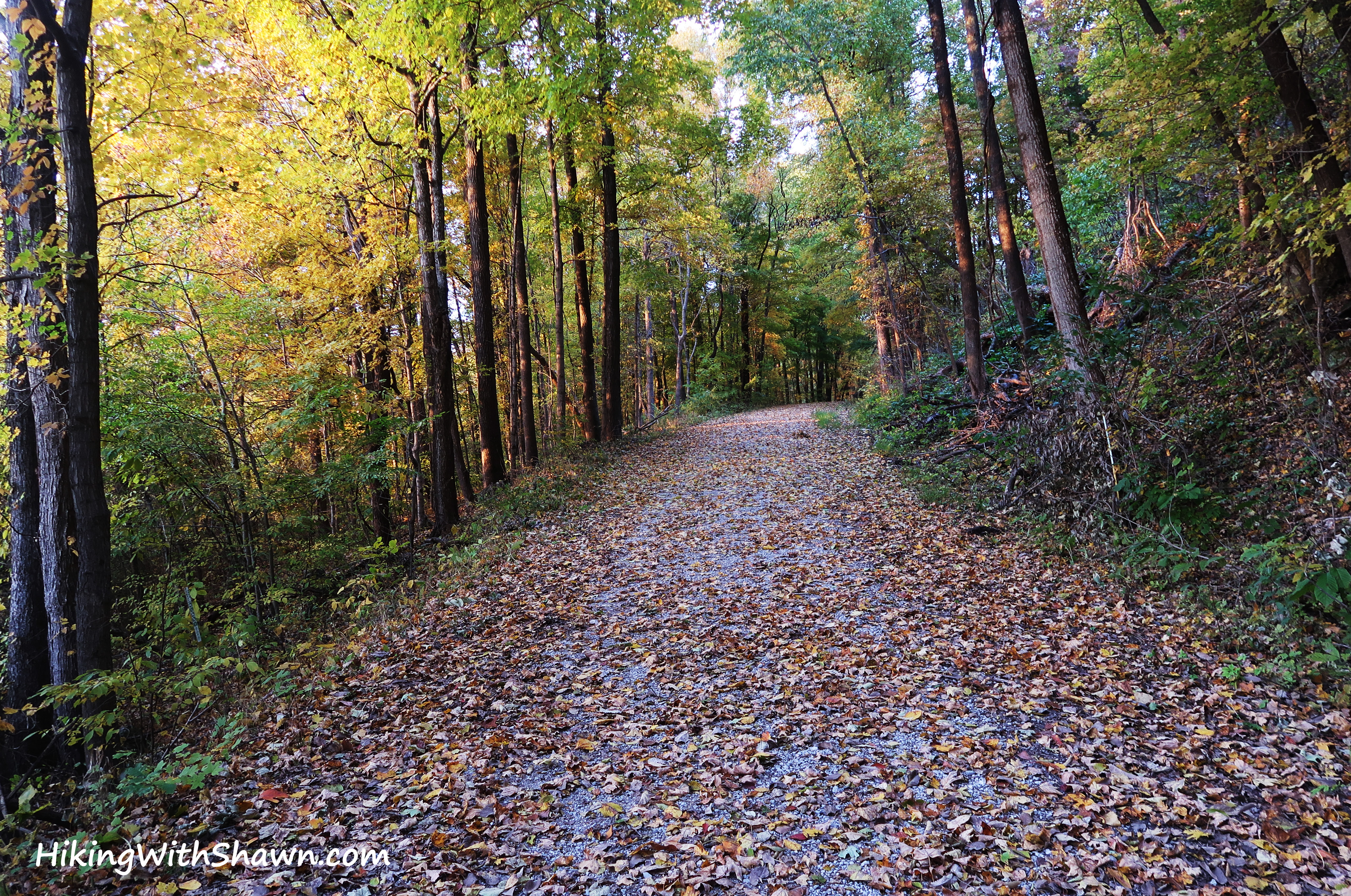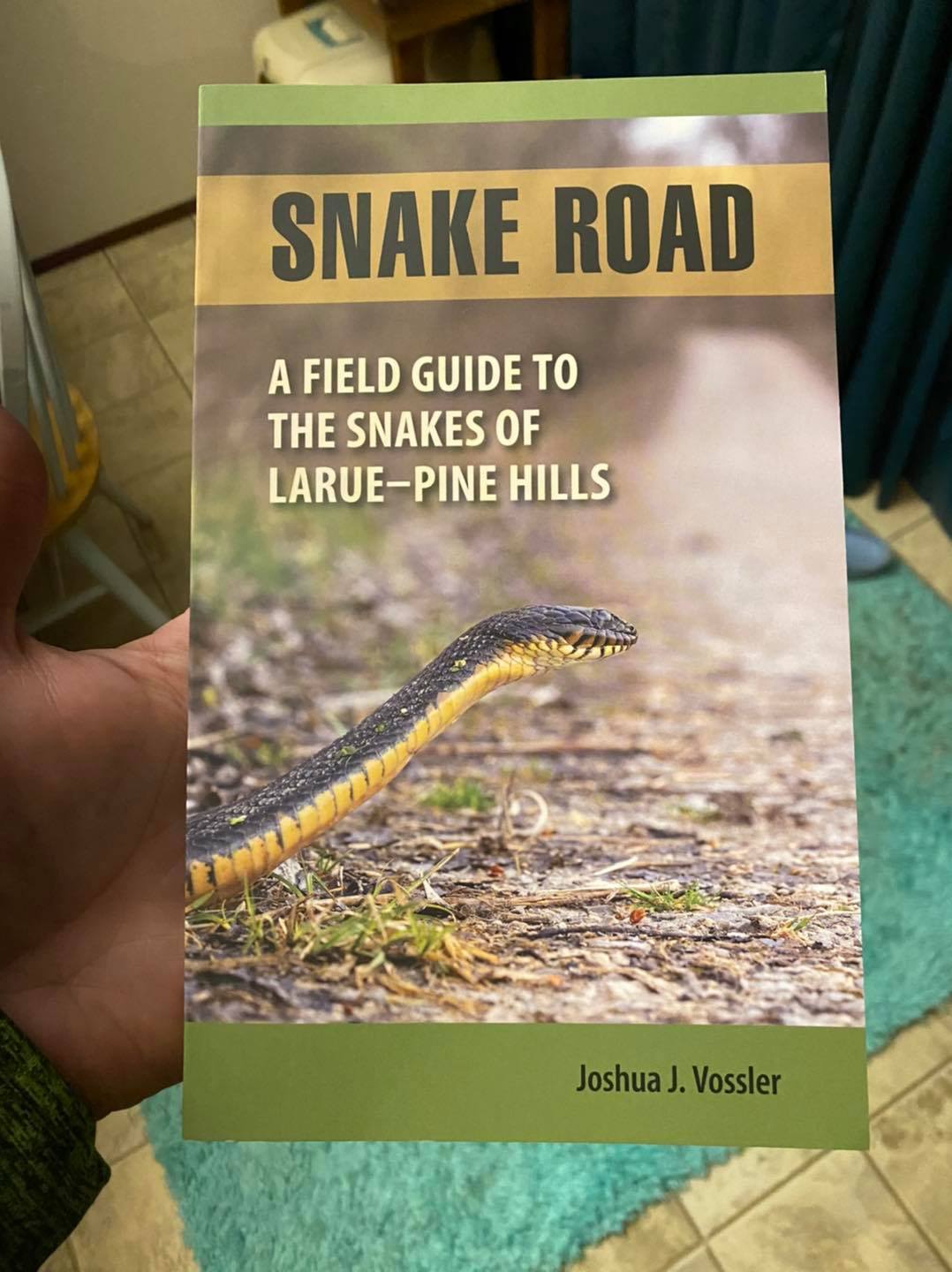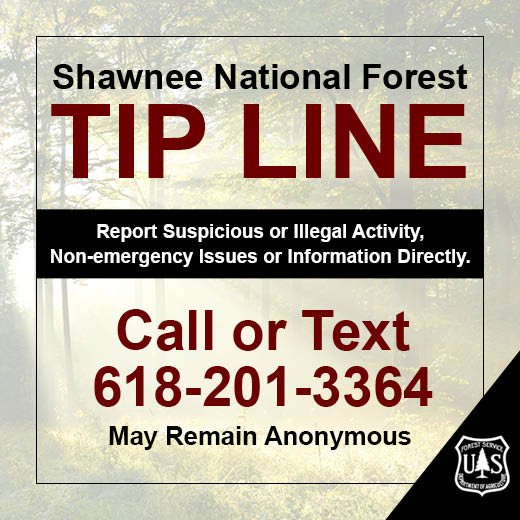Walking LaRue Pine Hills Snake Road
How to safely enjoy a walk on a road closed off for snake migration
LaRue Pine Hills Snake Road is Forest Service Road #345 located within the Mississippi Bluffs Ranger District of the US Forest Service managed Shawnee National Forest. Twice annually, LaRue Pine Hills Snake Road is closed for snake, reptile and amphibian migration. While the road is closed to motorized vehicles during migration, visitors on foot can freely travel on LaRue Pine Hills Snake Road. This guide was created to give you more information as well as safe usage tips.
Hiking with Shawn recommends the newly released (as of 2021) book, ‘Snake Road: A field guide to the snakes of LaRue Pine-Hills’ by Joshua Vossler, an avid snake watcher.
This book will tell you everything you need to know about LaRue Pine Hills Snake Road, the snakes present and how to identify them.
Get your copy from Amazon today at this link.
How to get to
LaRue Pine Hills Snake Road
LaRue Pine Hills Snake Road has two different trailheads, the north gate and the south gate. The north gate has more adequate parking space availability than the south gate. Using this Google Maps link, you can input directions from your location to the North Gate or use this Google Maps link in order to get to the South Gate. The road leading to the North Gate is mostly gravel with significant potholes throughout the road – it is advisable that you travel slowly to avoid hitting the potholes too quickly. Go down Muddy Levee Road from Route 3, crossing the rail road tracks and eventually coming to the T. Turn right and you will soon arrive to the North Trailhead with plenty of parking areas, grills and picnic tables and even a trashcan. Enjoy a glimpse of Winters Pond which was dug in order to create the levee for the Big Muddy River. There are no rest rooms at LaRue Pine Hills Snake Road.
One important note to touch base on when visiting LaRue Pine Hills Snake Road, especially for new visitors, is that many specific types of snakes, while present, are only seen on a rare occasion. I don’t want you to be bummed out if you drove 5 hours to see a Timber Rattlesnake or a Mudsnake for example as both of these species are not commonly seen. You will see more Cottonmouth and Water Snakes than anything else. Visit Snake Road with an open mind to see all types of snakes in their natural habitat and if you get lucky, you might witness some very interesting ones. There is nothing like Snake Road, visiting just to witness the area should be enough to make your trip worthwhile.
How to prepare for a walk at
LaRue Pine Hills Snake Road
While LaRue Pine Hills Snake Road is a part of the Shawnee National Forest, it isn’t the normal rugged hiking trail conditions that many of us are used to. It is a gravel forest road suitable for travel by motorized vehicles. The walk from gate to gate is roughly 2.7 miles on way. While most first time visitors walk only a small portion of the road during migration, more serious snake watching enthusiasts (often called, herpers) will walk from gate to gate, several times during their visit. While it is fairly easy to walk LaRue Pine Hills Snake Road, it is important to prepare yourself for the walk the right way, especially if it is your first visit to the road.
First a foremost, it is important to understand that there are no rest rooms at this location so do take care of those needs before your visit. You do not want to be forced to use the forest in an area where there are more than usual amounts of venomous snakes present. A good pair of hiking shoes or boots is recommended. This isn’t a good area to wear shorts or thin leggings. Wear thicker pants and consider higher boots to protect your ankles in the rare case of a snake bite. While you should not need a full day pack for your visit to LaRue Pine Hills Snake Road, it is recommended that you bring plenty of water and snacks during your visit. Bring a flashlight or a headlamp just in case and pack extra batteries.
DO NOT bring any sort of snake hook, tongs or a device used to tube and/or handle wildlife. Do not bring collection bags or cases. Bringing these items to LaRue Pine Hills Snake Road is illegal and is often reported by other visitors in the area. Violations of this federal law will likely result in equipment confiscation, expensive citations and potential arrest. Often time, federal and state law enforcement visit routinely and have also been known to hide in the forest and look for those who violate these federal regulations. Please allow the wildlife to continue to be wild by not tampering with them or attempting to handle them. Lastly, bring a camera or use your phone to take photos and videos of this very beautiful and scenic area of the Shawnee National Forest.
The Rules of
LaRue Pine Hills Snake Road
It is important that you understand and abide by the rules and federal regulations of LaRue Pine Hills Snake Road on your visit. Following these rules will help ensure that you have a positive visit without interruption. Before you go, please understand there is communities of Snake Road enthusiasts present at most times that will report illegal and/or suspicious activities in order to help protect the wildlife present on the road. Bending or violating the rules at LaRue Pine Hills Snake Road is simply not worth it.
- The collection, harassment, handling, harming or impeding traffic of any wildlife (including snakes) is prohibited. Tools and gear used for snake handling is prohibited.
- This is a pack it in, pack it out area meaning that there are no trash services. Please help us keep our forest clean by leaving no trace and taking your trash with you.
- This is a natural area meaning that during migration, motorized vehicles, horses and bicycles are not allowed. Foot travel is welcome.
- Camping and campfires are not allowed at LaRue Pine Hills Snake Road. There are grills and picnic tables available at the North Trailhead.
- Special-use permits are required for commercial filming and photography in any National Forest land. Please see the US Forest Service for more information on obtaining these permits.
Common Myths and Misconceptions of
LaRue Pine Hills Snake Road
It is important to understand that over the years, many myths and misconceptions have been created about LaRue Pine Hills Snake Road and snakes in general. This section of the guide was created to help disprove these myths and allow you to gain accurate information about where you will be visiting and wildlife that is present. Please help us educate the community by pointing out what are myths and what are not myths when you see them, especially when visiting sites on social media.
MYTH: When visiting LaRue Pine Hills Snake Road, you will see thousands of snakes crossing the road. FACT: Based on field research from an upcoming author writing about Snake Road, on average, a visitor will see 6 to 12 snakes per day when visiting Snake Road. My count is usually anywhere from 10 to 30 snakes and I usually visit anywhere from 3 to 7 days a week during an active migration spending 4 to 8 hours a day when visiting. There have been some days when I have seen over 100 snakes but not anywhere near 200. While some claim to have seen several hundred snakes a visit, the chance of anything remotely near 1,000 or more snakes a visit is practically impossible.
MYTH: People have died from snake bites while visiting LaRue Pine Hills Snake Road. FACT: There is no viable information available that suggests a human death has occurred from a bit occurring on Snake Road. In fact, the last recorded (but not certified) snake bite death in the State of Illinois was over 200 years ago and about two and a half hours north of LaRue Pine Hills Snake Road. However, over the years, there have been non-fatal snake bites occur on Snake Road. It is important to understand that venomous snakes are present at Snake Road. You avoid snake bites by watching where you are stepping next, not handling snakes and keeping a safe distance between you and a snake.
MYTH: All snakes on Snake Road are venomous. FACT: There are only three species of snakes that are venomous or a threat to human on Snake Road. These species are Copperheads, Cottonmouths and Timber Rattlesnakes. While not all snakes on Snake Road are venomous, the majority of what visitors will see are venomous as the cottonmouth is the most seen snake on the road. However, many of these snakes can still bite and should never be handled by humans.
MYTH: Snakes will chase you down and bite you. FACT: Snakes have no interest in interacting with human beings. Snakes are more afraid of us than we are of them. Snakes do not chase humans. Some claim that racers will mimic fleeing of human beings and appear to chase them but the moment you stop and turn around and chase them, they will flee from you. Snakes will only bite you if they are forced to defend themselves such as if handled or accidentally stepped on.
MYTH: Copperhead venom is harmless. FACT: While it is said that Copperhead venom isn’t as harmful as venom of a Timber Rattlesnake, people still have died from being bit by these snakes. Many people have initial allergic reactions that cause asphyxiation after being bit by a Copperhead. Avoid health concerns by not handling or getting close to any snake at LaRue Pine Hills Snake Road.
MYTH: Handling snakes on Snake Road is illegal but the law isn’t enforced. FACT: It is illegal to handle or collect snakes and other wildlife at LaRue Pine Hills Snake Road. These rules are enforced. Some video creators and photographers will often post their content showing handling these animals. There are many people who browse the web looking for content like this to report it. I have personally been given a card to a Forest service Law Enforcement Officer to call on if I see anyone handling snakes out there. It is enforced and the fines are really high – it isn’t worth it to harass the wildlife.
How to safely walk
LaRue Pine Hills Snake Road
The most important safety advice that I can give you when visiting LaRue Pine Hills Snake Road is to watch every step you take. This isn’t just to avoid stepping on a venomous snake; it is also to avoid stepping on harmless micro-snakes that are very tiny. Many species of wildlife depend on this area to migrate and the road is their path. As good stewards of the forest, we should help these critters have a safe migration across the road. It is important to ensure that you watch the steps of young children and pets as well. If a snake is stepped on, it might consider it a threat and bite to defend itself. Snakes are not aggressive, but they are defensive. You would be too if you were in their position.
Stay on the road itself. You will see plenty of wildlife by staying on the road. It may be tempting to go off trail or off the road but the risk of a close encounter with a venomous snake will only significantly rise at that point. Plenty of snakes will cross the actual road so it worth staying on the road. I have observed many different kinds of snakes on the road itself including copperheads, cottonmouths, timber rattlesnakes, water snakes, mud snakes, ribbon snakes, micro-snakes and green snakes. Many of the snakes are commonly seen around the areas of the road where the bluff is on one side and the swamp is on the other side.
Be sure to watch for snakes at eye level. In the fall of 2018, I observed a timber rattlesnake in a tree at face level for more than 7 days. It isn’t uncommon for cottonmouths to elevate themselves in trees. This is one reason why I advise folks to stay on the road and out the forest. There are probably snakes all over on the ground but there could be some in the trees right in your path as well. You do not want to get bit by a timber rattlesnake or any other venomous snake for that matter.
The road itself is wide enough for vehicles from both directions to drive. From gate to gate, one way, it is roughly 2.7 miles in length. While there are some hilly elevations present on the road, it is fairly easy to walk. There are no benches along the road or sources of adequate drinking water. There are some user-made and official trails along the road going into the forest. It is advisable not to use these trails during active migrations due to the risk of snakes more likely to be present and often hidden in leaves and underbrush. You will take a significant risk by choosing to walk off the road while visiting LaRue Pine Hills Snake Road.
If you encounter a snake of the road or near the road, please allow it 6 or more feet from your person in order to place a safe distance between you and the snake. Some snakes may show defensive signs warning you to stay away from them. These signs may include the shaking of the tail or rattle, gaping of the mouth or a position of striking might be observed. In some cases, snakes may emit a foul odor which is known as musk. As long as you do not handle and/or threaten the snake, you have nothing to fear. You may either wait for the snake to pass or move around giving it plenty of space while also keeping an eye out where you are stepping to move away from the snake. Never get too close to the snake or step right over it.
NOTICE: During the warmer months, mosquitoes and ticks are often present along LaRue Pine Hills Snake Road. It is advisable to use insect repellent and treat clothing and gear in anti-tick treatment. Tick-borne and other diseases may be present.
How to identify venomous snakes at
LaRue Pine Hills Snake Road
There are three species of venomous snakes within the area of LaRue Pine Hills Snake Road. These species are the copperhead snake, cottonmouth snake and the timber rattlesnake. You are most likely to encounter cottonmouth snakes more so than any other snake within the LaRue Pine Hills Snake Road area. On average, I may see 1-2 of the same snake of each species along with 1-2 dozen cottonmouths in a single visit. The cottonmouth is defiantly the king of LaRue Pine Hills Snake Road. It is important that you understand how identify the cottonmouth as well as the other venomous snakes on Snake Road.
The cottonmouth, also called water moccasin, holds the scientific name of Agkistrodon piscivorus. This is the most common snake (out of all the snakes) that is seen at LaRue Pine Hills Snake Road. This is also the most common venomous snake that is witnessed along the road as well. The cottonmouth has a blocky triangular to diamond shaped head and usually a very thick body. The cottonmouth will often flatten its body out to make it appear to look bigger than what it is when it feels threatened. The key defensive technique that a cottonmouth uses is extending its head upwards with its mouth facing up. It will then open its mouth and gape showing its white mouth which is what gives it the name, cottonmouth. This snake is venomous and the venom from this snake can be very disastrous to anyone who is bitten by one. Cottonmouths that are out of the neonate stage are often 1-4 feet in length, have pits above their nostrils and have vertical cat-like pupils in their eyes. Juvenile cottonmouths have a more striking coloration and pattern on their body while adults are darker. As a defense, cottonmouths will wiggle their tails, gape and show their mouths, musk, flatten their body out, erratically move around, false strike and even strike with venomous bite if threatened.
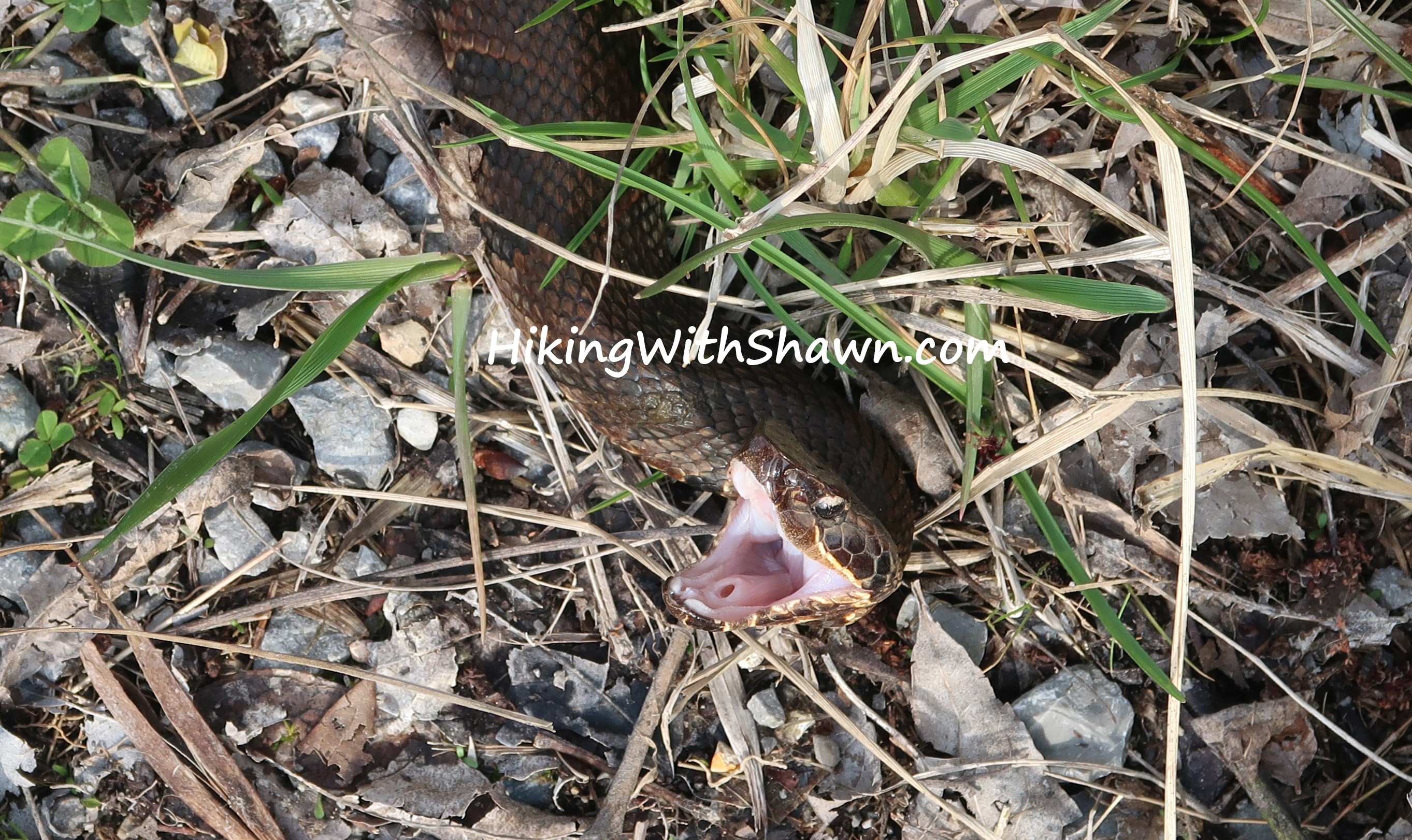
(Above Photo: Cottonmouth Gaping its mouth open as a sign of defense.)
The copperhead or Agkistrodon contortrix is also a common venomous snake seen at LaRue Pine Hills Snake Road. This snake has a triangular to diamond shaped head with vertical cat-like pupils in their eyes. Their body color is mainly of a copper-like color with pattern that is often described as looking like Hershey Kisses. Some warn that the copperhead tends to strike and attempt to bite more often than other venomous snakes. While that notion may be accurate, my own personal experiences in viewing copperheads have told me that it doesn’t happen all the time. I’ve never had one strike at me. It has been described that the bite of a copperhead is less toxic than bites from other local venomous snakes. However, there have been multiple human beings that have died from copperhead bites. It is important that you do not get bit from any snake.
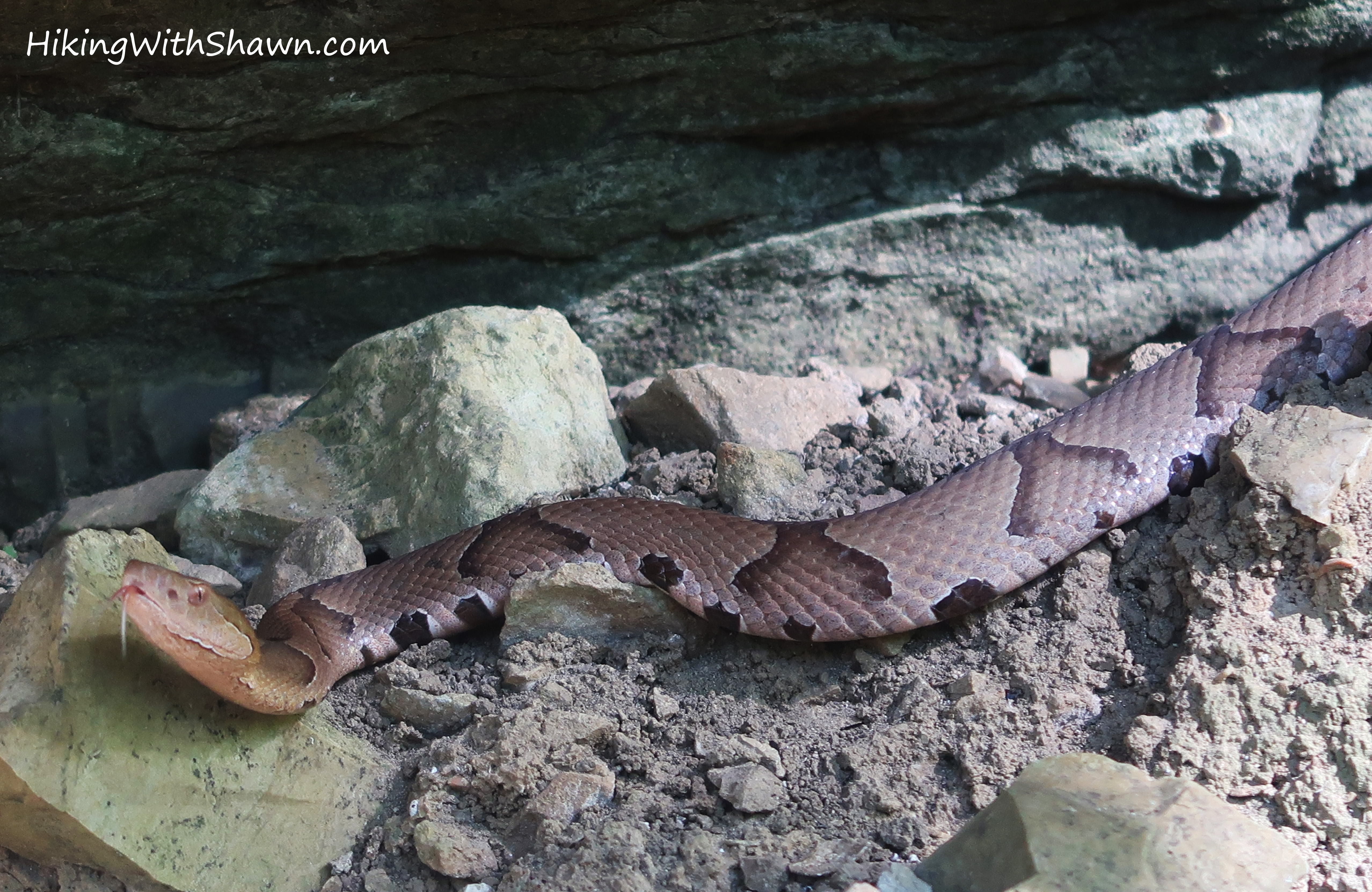
(Above Photo: Copperhead’s Hershey Kisses pattern in its banding.)
The Timber Rattlesnake or the Crotalus horridus is the most toxic venomous snake located at LaRue Pine Hills Snake Road. While the timber is regarded as the most dangerous snake venom-wise, it is one of the calmest snakes that you might encounter. I’ve personally witnessed dozens of timber rattlesnakes in my years of herping and never once did any of them rattle or get into a defensive position. Timber rattlesnakes in the area have been observed to be anywhere from 1-6 feet in length with most being in the 1-3 feet range. Encountering a timber rattlesnake is very rare but they are present at LaRue Pine Hills Snake Road. Most have a grayish coloration with dark brown to black cross-bands. A rust-colored vertebral line is often present on the snake. The amounts of rattles are pending on how many times the snake has shed whereas younger timber rattlesnakes may just have a button and no rattle present at all.

(Above Photo: A 3-4 year old Timber Rattlesnake.)
There are others snake present at LaRue Pine Hills Snake Road that are often misidentified as venomous snakes. In other areas of the regions, these misidentified snakes are often killed in fear that they are harmful. Snakes scare many people but it is important to understand that they are a wild animal that has a right to live just as any other animal. Snakes are also very beneficial to humans. Snakes often eat rodents that are carriers of Lyme disease, West Nile, Rocky Mountain spotted fever and other diseases that are more fatal to humans than snake bites are. Venomous snakes are often used to created ground-breaking medications for high blood pressure to fighting breast cancer. There are more benefits of snake than there are negatives and it is important that we shape generations to promote the protection of snakes as we do with other forms of wildlife.
What do I do if I get bit
by a Venomous Snake?
If you are bit by any snake at LaRue Pine Hills Snake Road or anywhere else for that matter, assume the snake that has bitten you, is indeed venomous. DO NOT try to take the snake or harm it, this will only increase your chances of getting bit again. The first thing you need to do is try to remain as calm as possible. Clean the wound and try to elevate the bite location above your heart. Do not use a snake bite kit or try to suck out the venom as this has been proven time and time again to be false. Do not cut into the bite area as this can increase your risk of infection. If an allergic reaction happens to a snake bite victim and there is an Epi-Pen on hand, inject it into the victim. Call 911 immediately following a snake bite or get the victim to a hospital as quickly as possible. Anti-venom treatment is very effective but also very expensive. Avoid this treatment by using common sense by watching where you are stepping and never handling snakes. Let wild animals be wild! DISCLAIMER: Hiking with Shawn, LLC is not a medical service and therefore is providing this information from public domain suggestions – this information is not to be seen as official medical advice.
What should I do if I see illegal activity
at LaRue Pine Hills Snake Road?
It is important to be a good steward of the forest. A part of being a good steward of the forest is to report illegal and/or suspicious activities when you observe them. While at LaRue Pine Hills Snake Road, if you observe violations of the rules especially in terms of handling, harming or collecting snakes and other wildlife – you are urged to report it. You may call or text the official Shawnee National Forest Law Enforcement Tip Line at 618-201-3364 and you are allowed to remain anonymous if you wish to do so. It is important to understand that we have a privilege to be able to walk the road during an active migration period. However, if an increase of rule violations were to occur, it would be critical for the US Forest Service and Illinois Department of Natural Resources to protect the wildlife and that could result in the closing of LaRue Pine Hills Snake Road to even pedestrians. Report any illegal activity or suspicious behaviors and help us protect the wildlife of Snake Road. This also includes people intentionally running over snakes when the road is open – get license plate and vehicle information and report it!
Interested in seeing more of
LaRue Pine Hills Snake Road?
Check out the videos below!
Thank you for taking the time to read my article about how to safely walk LaRue Pine Hills Snake Road. I hope this article was very resourceful for you. Please support my efforts of writing this article by sharing it with others, especially on your favorite social media websites. You can also support my efforts by subscribing to my YouTube Channel, liking me on Facebook and following me on Instagram and Twitter. I welcome you buy some of my official Merchandise to make a small monthly donation to my Patreon Page – donations will be used to better Hiking with Shawn. Please feel free to comment adding more to the discussion and until next time, I’ll see you on the trail!

Shawn J. Gossman
Host
Shawn is the founder and host of the YouTube Channel, Hiking with Shawn as well as Hiking with Shawn LLC. Shawn hikes, backpacks and visits various forested areas in the Shawnee National Forest, local state parks and other areas promoting outdoor recreational activities to obtain video to show to locals and non-locals alike. Please support Shawn’s efforts by sharing this post and leaving a comment below.

